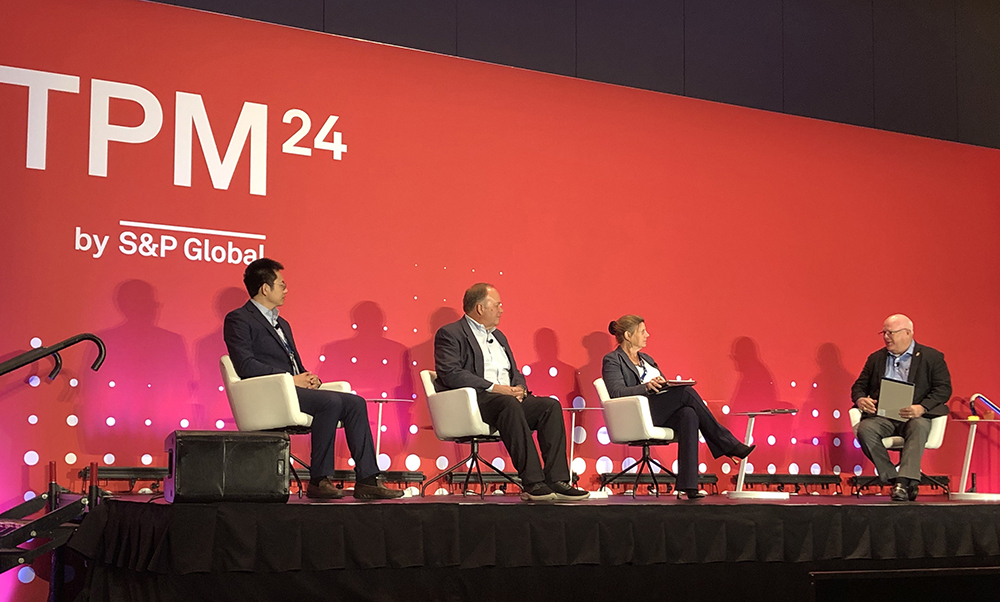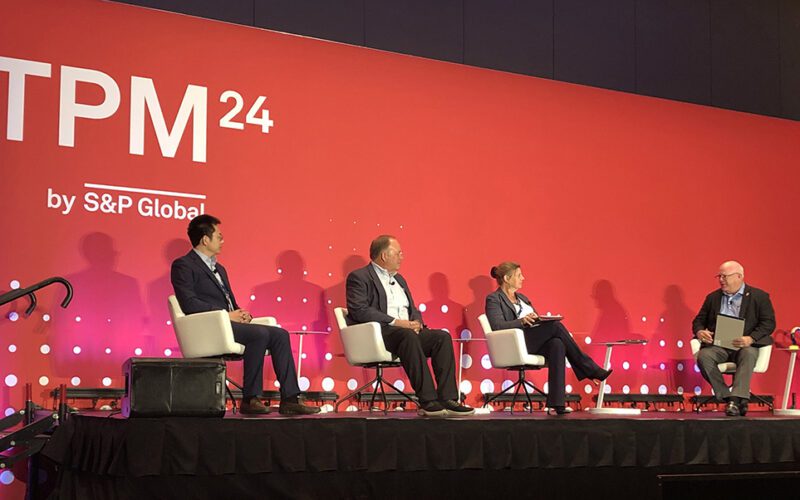
Despite the volatility of the refrigerated cargo market in recent years, some service providers plan to continue making investments in equipment and infrastructure to prepare for the next surge of reefer demand, according to a recent panel focused on the cold chain business.
The panel, titled “TPM Cold Chain: Recovering From the Abyss: How Service Providers Are Preparing for the Next Volume Surge,” was held March 6 at TPM24, the annual maritime industry event in Long Beach organized by the Journal of Commerce within S&P Global Market Intelligence.
The panel featured Port of Hueneme President and CEO Kristin Decas, J.B. Hunt Transport Services Senior Director of Temperature Control Systems James Schram and COSCO Shipping Lines General Manager of Reefer Trade Alex Yao, along with panel moderator Thomas Eskesen, founder of Eskesen Advisory.
Speakers shared their experiences handling cargo during and after the COVID-19 pandemic, and how they plan to move forward in the reefer market today and the coming years.
During the pandemic, the Port of Hueneme, like many ports, saw an uptick in cargo because of an increase in consumer spending.
“Our container business went up quite dramatically,” especially its container market, which was up close to 90%, Decas said.
She spoke of working with FedEx and J.B. Hunt, repositioning empties and bringing in commodities from the Asia TransPacific markets into the U.S.
Port numbers dropped post-COVID as Hueneme faced new challenges, including drops in commodities such as bananas and blueberries, which were affected by weather conditions, Decas said.
“There were big storms that caused a huge demise of the market sector; 50% of the blueberry market was impacted by poor weather,” she said.
Infrastructure, Equipment Investments
Meanwhile, Hueneme, known for its movement of agriculture and liquid bulk and autos, has become an emerging port in containerization, prompting the port look at improving its infrastructure to accommodate that business, according to Decas.
The port recently received an $80 million grant from California Gov. Gavin Newsom to make investments in its cold chain on-dock and plans to use some of that money for additional reefer plugs that are expected to run on green hydrogen.
The port is also planning to demolish obsolete warehouses that used to service the break bulk industry and make other improvements and staging efficiencies, Decas said.
“So when we look at improvements inside the gate, we want to do things so that we can move cargo quickly and expedite that movement to those terminals outside the gate,” she explained.
Over the last seven years, J.B. Hunt has grown its refrigerated capacity from 200 refrigerated containers to more than 5,000 now, Schram said. He added that getting more equipment was a big problem during COVID.
The company had about 1,200 containers, brand new add-ons, that were supposed to come in at the start of 2022, but didn’t arrive until the end of 2023.
“During COVID, we had to flex to support our customers in what we can do” with the refrigerated units the company did have, he said.
“The boxes are coming out of China; refrigeration units coming out of Ireland, so we have to match them up in Long Beach and have them put together,” Schram said. “And then we’re bringing on equipment. It really made it tough.”
Now demand is down and the surplus equipment ordered in 2022-2023 is arriving ahead of schedule, he said.
“We’re seeing quite a few of our competitors basically scaling back on new equipment; we are not,” Schram said. “We see a pretty good future in what’s coming down the line for us.”
Ocean carriers including COSCO Shipping also had equipment challenges, much of which was farmed out to various service routes, Yao said.
Post COVID, COSCO Shipping has been actively ordering equipment and has a new delivery of high-capacity reefer plugs, Yao said.
For example, COSCO Shipping has a series of new 14,000 TEU vessels and 2,100 reefer plugs that were delivered last September, “which I think is a good addition for all our customers in Latin America,” Yao said.
Yao doesn’t view buying more equipment as a redundancy and anticipates more equipment investment by ocean carriers and said that “disruption can be anywhere.”
“It’s actually a buffer that we need in place to put into any place that we need the reefer box ready,” he explained, adding that COSCO Shipping has been adding new reefer boxes by double digits.
Sustainability
Sustainability will be top of mind in the coming years in terms of investments and tackling regulatory challenges, panelists said.
Those challenges include a California Air Resources Board regulation requiring diesel trucks to be updated to curb emissions and a mandate that roll-on/roll-off ships are expected to start plugging in on Jan. 1 of next year.
There’s also the challenge of the availability of alternate fuels.
“That’s why I think a lot of big players (are) trying to do diversification,” with some exploring other fuel sources and electricity, Yao remarked.
COSCO Shipping has two prototype vessels with a capacity of about 700 TEUs that feature swappable batteries for easy charging, Yao said.
Hueneme has been very progressive in this space and is looking to decarbonize its footprint by 2030, Decas said. The port is looking at electrifying its cargo handling equipment, bringing in solar power solutions and other alternative energy sources.
The port also has $23 million from grants to electrify terminals and offer plug-in capability to vessels.
“You have to be green to get green,” Decas said. “These days, there’s just no question about it.”

